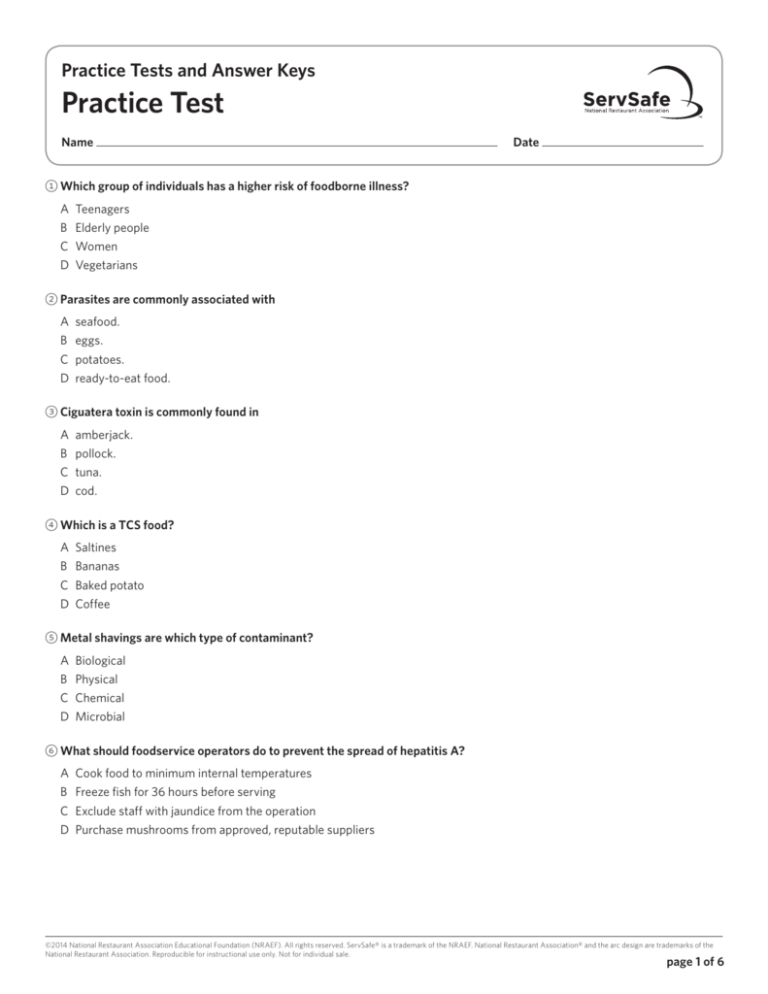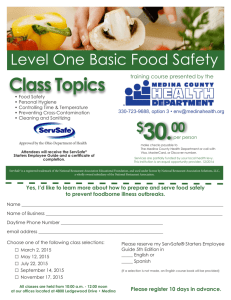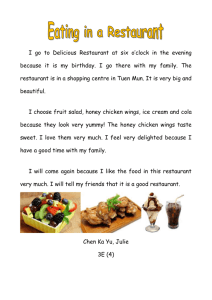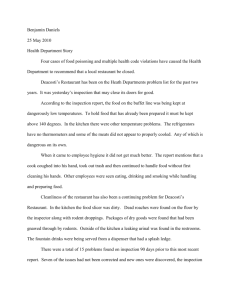
Practice Tests and Answer Keys
Practice Test
Name
Date
1 Which group of individuals has a higher risk of foodborne illness?
A
B
C
D
Teenagers
Elderly people
Women
Vegetarians
2 Parasites are commonly associated with
A
B
C
D
seafood.
eggs.
potatoes.
ready-to-eat food.
3 Ciguatera toxin is commonly found in
A
B
C
D
amberjack.
pollock.
tuna.
cod.
4 Which is a TCS food?
A
B
C
D
Saltines
Bananas
Baked potato
Coffee
5 Metal shavings are which type of contaminant?
A
B
C
D
Biological
Physical
Chemical
Microbial
6 What should foodservice operators do to prevent the spread of hepatitis A?
A
B
C
D
Cook food to minimum internal temperatures
Freeze fish for 36 hours before serving
Exclude staff with jaundice from the operation
Purchase mushrooms from approved, reputable suppliers
©2014 National Restaurant Association Educational Foundation (NRAEF). All rights reserved. ServSafe® is a trademark of the NRAEF. National Restaurant Association® and the arc design are trademarks of the
National Restaurant Association. Reproducible for instructional use only. Not for individual sale.
page 1 of 6
Practice Tests and Answer Keys Practice Test
7 To wash hands correctly, a food handler must first
A
B
C
D
apply soap.
wet hands and arms.
scrub hands and arms vigorously.
use a single-use paper towel to dry hands.
8 What should foodservice operators do to prevent customer illness from Shigella spp.?
A
B
C
D
Freeze food at temperatures below 0˚
Exclude food handlers diagnosed with jaundice
Purchase shellfish from approved suppliers
Control flies inside and outside the operation
9 What must a food handler with a hand wound do to safely work with food?
A
B
C
D
Bandage the wound with an impermeable cover and wear a single-use glove
Bandage the wound and avoid contact with food for the rest of the shift
Wash the wound and wear a single-use glove
Apply iodine solution and a permeable bandage
!0 What item is considered acceptable work attire for a food handler?
A
B
C
D
False eyelashes
Nail polish
Plain-band ring
Antimicrobial plastic watch band
!1 What task requires food handlers to wash their hands before and after doing it?
A
B
C
D
Taking out garbage
Touching clothing or aprons
Handling raw meat, poultry, or seafood
Using chemicals that might affect food safety
!2 Which action requires a food handler to change gloves?
A
B
C
D
The food handler is working with raw seafood at temperatures above 41˚F (5˚C)
The food handler is prepping raw chicken on a yellow cutting board
The food handler has been working with raw ground beef for an hour
The food handler is wearing gloves that have been torn
!3 How should the temperature of a shipment of cottage cheese be taken when it arrives at an operation?
A
B
C
D
Use an air probe to check the temperature of the delivery truck
Hold an infrared thermometer to the outside of the case or carton
Place the thermometer stem between shipping boxes for a reading
Place the thermometer stem into an opened container
©2014 National Restaurant Association Educational Foundation (NRAEF). All rights reserved. ServSafe® is a trademark of the NRAEF. National Restaurant Association® and the arc design are trademarks of the
National Restaurant Association. Reproducible for instructional use only. Not for individual sale.
page 2 of 6
Practice Tests and Answer Keys Practice Test
!4 When should a shipment of fresh chicken be rejected?
A
B
C
D
The flesh of the chicken appears moist.
Shellstock identification tags are not attached to the container.
The flesh of the chicken is firm and springs back when touched.
The receiving temperature is 50˚F (10˚C).
!5 Where should ground fish be stored in a cooler?
A
B
C
D
Above shellfish
Below ground poultry
Above ready-to-eat food
Below pork roasts
!6 What is the maximum number of days that ready-to-eat food prepared on-site can be stored if held at 41˚F (5˚C)?
A
B
C
D
3 days
5 days
7 days
10 days
!7 In top-to-bottom order, how should a fresh beef roast, fresh halibut, lettuce, and a pan of ground chicken be stored
in a cooler?
A
B
C
D
Lettuce, fresh beef roast, ground chicken, fresh halibut
Lettuce, fresh halibut, fresh beef roast, ground chicken
Fresh halibut, lettuce, ground chicken, fresh beef roast
Fresh halibut, fresh beef roast, ground chicken, lettuce
!8 What organization requires Material Safety Data Sheets?
A
B
C
D
Food and Drug Administration
Occupational Safety and Health Administration
Environmental Protection Agency
National Restaurant Association
!9 What is the minimum internal cooking temperature for green beans that are hot-held for service?
A
B
C
D
165˚F (74˚C)
155˚F (68˚C)
145˚F (63˚C)
135˚F (57˚C)
@0 What food item does the Food and Drug Administration advise against offering on a children’s menu?
A
B
C
D
Rare cheeseburgers
Egg salad
Peanut butter and jelly sandwiches
Fried shrimp
©2014 National Restaurant Association Educational Foundation (NRAEF). All rights reserved. ServSafe® is a trademark of the NRAEF. National Restaurant Association® and the arc design are trademarks of the
National Restaurant Association. Reproducible for instructional use only. Not for individual sale.
page 3 of 6
Practice Tests and Answer Keys Practice Test
@1 TCS food reheated for hot-holding must reach what temperature?
A
B
C
D
135˚ (57˚C) for 15 seconds
145˚ (63˚C) for 15 seconds
155˚ (68˚C) for 15 seconds
165˚ (74˚C) for 15 seconds
@2 What method should never be used to thaw food?
A
B
C
D
Place the item in a cooler
Place the item on a prep counter
Microwave the item
Cook the item
@3 When partial cooking food to be finished later, what is the maximum cooking time allowed during initial cooking?
A
B
C
D
60 minutes
45 minutes
30 minutes
15 minutes
@4 Food held at 41˚F (5˚C) or lower before being removed from refrigeration can be held without temperature control for up to
how many hours?
A
B
C
D
2
4
6
8
@5 Hot TCS food can be held without temperature control for a maximum of
A
B
C
D
2 hours.
4 hours.
6 hours.
8 hours.
@6 Which food may be re-served to customers?
A
B
C
D
Unused, uncovered condiments
Uneaten bread
Unopened pre-packaged food
Unused whole fruit garnish
@7 What is the purpose of setting critical limits in a HACCP plan?
A
B
C
D
To identify potential hazards
To identify where hazards can be eliminated
To reduce hazards to safe levels
To determine if the HACCP plan is working
©2014 National Restaurant Association Educational Foundation (NRAEF). All rights reserved. ServSafe® is a trademark of the NRAEF. National Restaurant Association® and the arc design are trademarks of the
National Restaurant Association. Reproducible for instructional use only. Not for individual sale.
page 4 of 6
Practice Tests and Answer Keys Practice Test
@8 What is the minimum water temperature required when using hot water to sanitize objects?
A
B
C
D
171˚F (77˚C)
173˚F (78˚C)
176˚F (80˚C)
179˚F (81˚C)
@9 What HACCP principle is being practiced when food handlers rewash melons that have surface dirt?
A
B
C
D
Monitoring
Corrective action
Critical limit
Critical control point
#0 What is the final step in cleaning and sanitizing a prep table?
A
B
C
D
Sanitizing the surface
Allowing the surface to air-dry
Washing the surface
Rinsing the surface
#1 What is the minimum time an iodine sanitizer solution must be in contact with the object being sanitized?
A
B
C
D
15 seconds
30 seconds
45 seconds
60 seconds
#2 If a food-contact surface is in constant use, how often should it be cleaned and sanitized?
A
B
C
D
Every 2 hours
Every 4 hours
Every 6 hours
Every 8 hours
#3 What is the third step in cleaning and sanitizing items in a three-compartment sink?
A
B
C
D
Sanitizing
Air-drying
Rinsing
Washing
#4 What type of thermocouple probe should be used to check the internal temperature of a beef roast?
A
B
C
D
Air
Surface
Immersion
Penetration
©2014 National Restaurant Association Educational Foundation (NRAEF). All rights reserved. ServSafe® is a trademark of the NRAEF. National Restaurant Association® and the arc design are trademarks of the
National Restaurant Association. Reproducible for instructional use only. Not for individual sale.
page 5 of 6
Practice Tests and Answer Keys Practice Test
#5 What food safety practice can prevent cross-contact?
A
B
C
D
Using only food-grade equipment
Washing, rinsing, and sanitizing utensils before each use
Keeping food frozen until use
Purchasing food from approved, reputable suppliers
#6 What is the most likely cause of wheezing and hives?
A
B
C
D
Food allergies
Norovirus
Shigella spp.
Hepatitis A
#7 What is a basic characteristic of a virus?
A
B
C
D
Destroyed by cooking
Grows in food
Requires a living host to grow
Commonly found in cattle intestines
#8 Where should staff members eat, drink, smoke, or chew gum?
A
B
C
D
Where customers eat
In dishwashing areas
Outside the kitchen door
In designated areas
#9 When can a food handler with a sore throat and a fever return to work with or around food?
A
B
C
D
The fever is gone for 24 hours.
The sore throat is gone.
A written medical release is provided.
No symptoms are experienced for 24 hours.
$0 What should a foodservice operator do when responding to a foodborne-illness outbreak?
A
B
C
D
Notify the media
Segregate the product
Close the operation for the day
Ask customers for proof of their symptoms
©2014 National Restaurant Association Educational Foundation (NRAEF). All rights reserved. ServSafe® is a trademark of the NRAEF. National Restaurant Association® and the arc design are trademarks of the
National Restaurant Association. Reproducible for instructional use only. Not for individual sale.
page 6 of 6
Practice Tests and Answer Keys
Practice Test Answer Key
1B
@1 D
2A
@2 B
3A
@3 A
4C
@4 C
5B
@5 B
6C
@6 C
7B
@7 C
8D
@8 A
9A
@9 B
!0 C
#0 B
!1 C
#1 B
!2 D
#2 B
!3 D
#3 C
!4 D
#4 D
!5 D
#5 B
!6 C
#6 A
!7 B
#7 C
!8 B
#8 D
!9 D
#9 C
@0 A
$0 B
©2014 National Restaurant Association Educational Foundation (NRAEF). All rights reserved. ServSafe® is a trademark of the NRAEF. National Restaurant Association® and the arc design are trademarks of the
National Restaurant Association. Reproducible for instructional use only. Not for individual sale.
page 1 of 1






